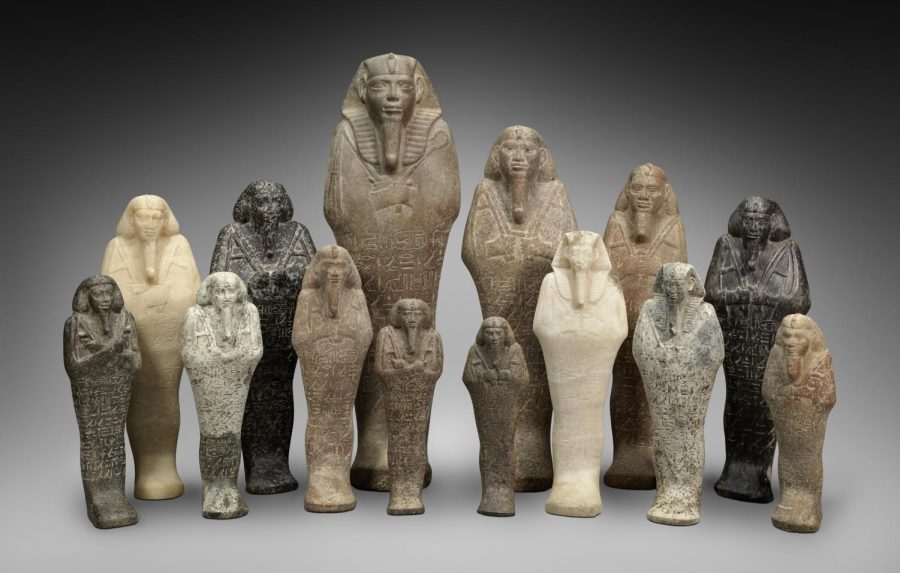New MFA exhibition explores a misrepresented ancient civilization
Photo courtesy Amelia Kantrovitz, Museum of Fine Arts
“Shawabty of King Taharqa” is one of the works in the MFA’s new exhibition “Ancient Nubia Now,” opening Oct. 13.
October 9, 2019
“Ancient Nubia Now,” the Museum of Fine Arts’ new exhibition opening Oct. 13, spans thousands of years and presents a massive selection of Nubian art, jewelry, pottery, sculptures and more — the largest collection of Nubian art outside of Sudan. These royal artifacts, some on display for the first time, invite each visitor to view centuries of once-forgotten history through a contemporary lens.
A single figure, framed by a halo of light, greets visitors as they enter the shadowy halls of the museum. The small statuette of King Taharqa provides a brief glimpse of what’s to come: a selection honoring the grandeur of a bygone African kingdom. The exhibition unearths the secrets of Nubia’s history, illuminating a past marred by ancient Egypt’s intolerance and Western bias.
“Many people — and this is a key point to stress — are unaware of the artistry that flourished during this era,” said Matthew Teitalbaum, the museum director. “That’s in part because Nubia’s story has been told by others.”
Misleading accounts of Nubian history stretch back for generations. The exhibition exposes these inaccuracies, shining a light on prejudices that prevented Nubian art from reaching much of the world. It reveals a story of oppression, both from neighboring Egyptians and European colonists hundreds of years later.
“[The exhibit] challenges racist colonial distortions and misrepresentations of Nubia that plagued considerations of its heritage for a very long time,” said Edmund Barry Gaither, special consultant at the Museum of Fine Arts, or MFA.
Nicole N. Aljoe, a professor of African American studies at Northeastern, encourages her students to take full advantage of the museum’s resources. To Aljoe, attending the exhibit is about discovering a culture that most people know little about.
“[Nubia] represents this royal history of Africa that folks can put beside and challenge representations of Africa as having no culture — Africans are inherently to be enslaved, that kind of thing,” Aljoe said.
The MFA seeks to intertwine Nubia’s rich history with its presence in modern-day society. By featuring insight from contemporary voices — including student Lana Bashir, photographer Chester Higgins, anthropologist Dr. Shomarka Keita and more — the exhibition chronicles the impact of Nubia on today’s society.
“This exhibition reminds us that despite being thousands of years old, Nubia still resonates in many ways today,” said Denise Doxey, a curator at the MFA.
Even today, there is a movement to rename Roxbury’s Dudley Square to Nubian Square. Roxbury is one of Boston’s largest black communities, and many residents are pushing for the town center to reflect their heritage. The square is currently named after the second governor of Massachusetts Bay Colony, Thomas Dudley, a Puritanical man who presided over laws permitting slavery. Rather than commemorating this politician, activists hope the square can celebrate African ancestry.
“There is a great effort to reclaim these heritages and make them relevant in the world in which we live,” Gaither said.
Grandiose figurines, hand-crafted from meticulously carved granite, line the walls of the exhibition’s central room. The stone faces stare outward, illuminated by a subtle glow. Hundreds of these relics were excavated, and each depicts Nubian royalty. The sheer number of these chiseled kings speak to the vastness of the Nubian empire.
Next year, the MFA will reach its 150th anniversary, a benchmark it seeks to recognize by promoting inclusivity. Students who visit will be given four free admission passes to the exhibition, in hopes that they will return with their families and spread awareness about this historical archive. The museum will also donate the same passes to sixth grade students in schools teaching Nubian history.
“It’s the spirit of generosity, thoughtfulness about connecting, and the belief that we have that institutions should be places of belonging for all in our community,” Teitelbaum said.
Teitelbaum said he always repeats his considerate mantra to his staff: “The more we give, the richer we are.”
The exhibition is free to students and will be open until Jan. 20, 2020.







